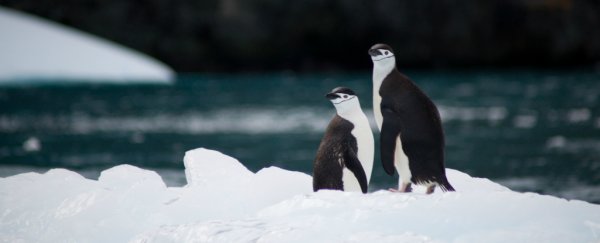A proposal to create the world's largest marine reserve in Antarctica is dead in the water after failing to secure unanimous support from participating nations.
If it had passed, the vast sanctuary would have been the largest wildlife reserve on Earth, protecting three new regions in the icy south, a total of 1.8 million square kilometres of ocean wilderness (700,000 square miles).
By banning all commercial fishing in an area five times the size of Germany, numerous marine species including orcas, blue whales, seals, and penguins would have been protected from human exploitation. On top of that, species humans rely on for fishing would have dedicated space to breed and keep up their numbers for the future.
Now, however, the future of these ecosystems - and the species that rely on them - is unclear.
Negotiations on the proposal were recently held in Tasmania by the Commission for the Conservation of Antarctic Marine Living Resources (CCAMLR), which is made up of 24 countries and the European Union (EU).
But while the vast majority of countries favoured the resolution, there was still "much discussion" among the delegates. According to Greenpeace and Aljazeera, during the two weeks of deliberation, spokespersons from China, Norway and Russia voiced enough reservations that the landmark proposal was stopped in its tracks.
"This was an historic opportunity to create the largest protected area on Earth in the Antarctic: safeguarding wildlife, tackling climate change and improving the health of our global oceans," said Frida Bengtsson of Greenpeace's Protect the Antarctic campaign.
"Twenty-two delegations came here to negotiate in good faith but, instead, serious scientific proposals for urgent marine protection were derailed by interventions which barely engaged with the science and made a mockery of any pretense of real deliberation."
In notes from the meeting, it appears that China and Russia drove most of the resistance. Delegates from both of these nations repeatedly claimed that there was not enough baseline science to support the wildlife sanctuary, citing the need for further data and analysis.
The EU was not going to buy that excuse.
"The EU and its member States note with regret that this is the seventh consecutive year that the EAMPA proposal has been discussed without result," a statement from the EU delegate reads.
"Considering that the Scientific Committee considered already in 2013 that the proposal is based on best available science, the EU and its Member States cannot accept that new demands for more scientific work are being made by some delegations year after year," the statement continues.
Studies have shown that creating ocean spaces free from fishing and drilling improves the health of wildlife, protects biodiversity and makes ecosystems more resistant to climate change.
In 2009, the CCAMLR agreed to create a network of havens to protect wildlife from fishing in the Antarctic. But now, nearly ten years on, the commission has not followed through on its promise, putting the whole region at risk.
A study published last year found that at the current rate of fishing, none of the species currently extracted in Antarctica will survive to 2020.
"We're running out of time and scientists are clear that we need to create marine sanctuaries across at least 30 percent of our oceans by 2030, to protect wildlife, ensure food security for billions and help to tackle climate change," said Bengtsson.
Protecting krill in Antarctica is particularly important, as these little crustaceans absorb vast amounts of carbon dioxide and are an important source of food for both penguins and whales.
The new proposal would have completely banned krill fishing in the Weddell Sea and parts of the Antarctic peninsula.
So it should come as no surprise that China, Norway and Russia are all heavily involved in krill fishing. In fact, five fishing firms from Norway, Chile, South Korea and China account for 85 percent of all krill catches in the Antarctic.
Greenpeace is now accusing China, Norway and Russia of being more concerned with expanding fisheries than with conservation.
"Rather than put forward reasoned opposition on scientific grounds, some delegations, like China and Russia, instead deployed delaying tactics such as wrecking amendments and filibustering, which meant there was barely any time left for real discussion about protecting Antarctic waters," said Bengtsson.
The current target, set by the United Nations Convention on Biological Diversity, is to protect at least 10 percent of coastal and marine areas by 2020. In September, the UK proposed that goal be boosted to 30 percent by 2030.
But without immediate global cooperation, neither of these targets is likely to be met.
As of March 2017, one study found that only 3.5 percent of the ocean was within a marine protected area, and only 1.6 percent was in a strongly protect marine sanctuary.
With the CCAMLR failing to take action, the future of Antarctic oceans are now in the hands of the UN, which is working on a global ocean treaty for 2020.
"Marine protection should be the rule, not the exception," said head of UN Environment Erik Soldheim at a general assembly in September.
"Particularly for the most vulnerable, high-traffic and resource-rich marine habitats, the time for effective management and action on our oceans and seas is now."
